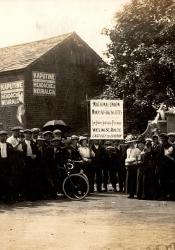Foundation of the NUWSS
In November of 1897, two suffragist organizations, the National Central Society for Women's Suffrage and the Central Committee of the National Society for Women's Suffrage, united to form a group known as the National Union of Women's Suffrage Societies (NUWSS). This new group would be the largest organization of suffragists in Britain. The group was placed under the leadership of Millicent Fawcett, who would lead the new organization for more than twenty years, and establish them as a major political influence. The group advocated for suffrage politically, but avoided the more violent tactics of suffragettes, leading to a fracturing in the group that would produce the Women's Social and Political Union (WSPU). They also allowed men to be members of the organization, in contrast with more extremist groups. To advance their cause, the group engaged in campaigning against political parties that refused to address suffrage, and for those politicians who sought to address the issue. One of their early coordinated actions was a boycott of the Liberal Party in the election of 1906. Their attacks on the Liberal Party are thought to be a contributing factor in the party's replacement by the Labour Party. The NUWSS also coordinated a large march for suffrage in 1907, which was so plagued by rain that it came to be known as "the Mud March". They continued to engage in political advocacy, going so far as to raise funds to fight anti-suffrage candidates in the election of 1912. In 1913 the NUWSS organized their largest march ever, dubbed by newspapers "The Great Pilgrimage". The organization continued on a similar course until it was reorganized and renamed as the National Union of Societies for Equal Citizenship (NUSEC) in 1919.
The linked sources are useful for establishing core tenets of the organization. The first is a retrospective on women's marches, which includes useful information about two of the major marches coordinated by the NUWSS. The second is a set of scans of pamphlets issued by the NUWSS. These pamphlets break down some of the major talking points of the NUWSS for Victorian readers, allowing modern readers insight into both their key talking points and how they presented those talking points. The final article is an in-depth analysis of the contributions of NUWSS to the cause of suffrage, with specific emphasis put upon their leader Millicent Fawcett.
Lethbridge, Lucy. "The women’s March: How the Suffragettes Changed Britain."FT.Com, 2018. ProQuest, http://ezaccess.libraries.psu.edu/login?url=https://search-proquest-com.....
“NUWSS Pamphlets.” The British Library, The British Library, 3 Aug. 2017, www.bl.uk/collection-items/nuwss-pamphlets.
Rubinstein, David. “Millicent Garrett Fawcett and the Meaning of Women's Emancipation, 1886-99.” Victorian Studies, vol. 34, no. 3, 1991, pp. 365–380. JSTOR, www.jstor.org/stable/3828580.

